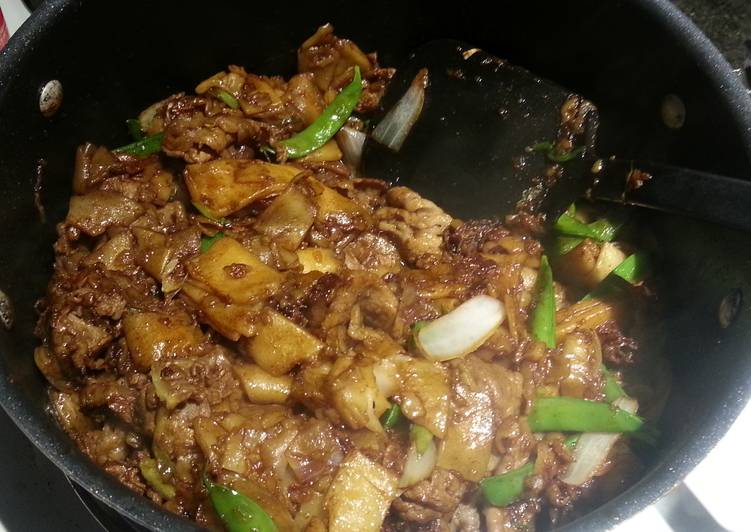Classic Chinese Beef with Fat Noodles. This is the stir fried noodles version of everybody's favourite Chinese Beef and Broccoli. I've been to China and Hong Kong several times and I can honestly say I do not recall ever seeing it on a menu, and I remember reading somewhere that broccoli is actually quite expensive in China. This fragrant recipe for Chinese Beef Noodle Soup is a delicious, and healthy soup that makes the perfect warming meal.
 It just makes things simpler as you cook.
Begin with browning the meat with garlic, fresh ginger.
Here is a recipe on how to make traditional Chinese beef noodle soup.
You can cook Classic Chinese Beef with Fat Noodles using 9 ingredients and 14 steps. Here is how you cook it.
It just makes things simpler as you cook.
Begin with browning the meat with garlic, fresh ginger.
Here is a recipe on how to make traditional Chinese beef noodle soup.
You can cook Classic Chinese Beef with Fat Noodles using 9 ingredients and 14 steps. Here is how you cook it.
Ingredients of Classic Chinese Beef with Fat Noodles
- You need 400 grams of Chinese fat noodles, 1 inch width (Typically 1 in width for traditional style. However, you can get the folded up sheets and cut it into any width you prefer, or buy per-cut ones if no preference. ) (Make sure the noodle is NOT TOO WET! It should be mil.
- It's 100 grams of thin sliced beef (The kind used for hot pot with relatively higher fat to muscle ratio. The fatties, the better).
- You need 1 of whole white onion, cut in wedges..
- It's 100 grams of (Optional) starchy (or tough) vegetable (i.e. peapods, broccoli stem, etc.).
- Prepare 3 tbsp of soy sauce.
- Prepare 1 tbsp of oyster sauce or 1 tbsp of Hondashi (Japanese dried fish stock).
- You need 1/2 tbsp of sugar.
- You need 2 tbsp of cooking rice wine (or any cooking alcohol you find really).
- You need 1 of Salt.
This is just as good as some of the traditional Taiwanese beef noodle soups that I. Beef noodle soup possibly is the most favorited Chinese style noodle soup. Every noodle restaurant serve their own beef noodle. You can find beef hand pulled noodles (牛肉拉面) in Lanzhou noodle restaurant, a spicy Sichuan style braised beef noodle in a Sichuan restaurant, a much milder.
Classic Chinese Beef with Fat Noodles step by step
- Heat up a large non-stick skillet (or frying pan) under HIGH heat until it is sizzling hot. (I like to use a skillet because the higher raised lip limit the extend of flying grease when pan-frying and stops things from falling out of the skillet.).
- Drop in the thin sliced beef in bundles (3-4 slices) directly into the skillet..
- Brown the meat on both sides for a good 7 second. Tips: 1) Give each bundle enough space apart (at least 1/2 inch apart) to prevent juice from pooling. 2) Limit movement of the meat during browning to prevent sticking. 3) Ideally, it's brown on the outside and raw on the inside. You will cook them again the noodle later. If too cooked, it will dry up..
- Remove the skillet from heat..
- Extract the meat with chopsticks or tongs when the meat is properly browned on both surfaces. Leave the rendered grease in the skillet for the next step..
- Add the onion, the peapods, and a pinch of salt into the skillet and cook under HIGH heat until soften. Tips: Typically around 30 seconds. Stir often. I usually pop the lid on and whirl the content around instead for quicker result. It effectively "braises" the veggies along with frying..
- Add the noodles into the skillet..
- There should still be a layer of grease remains on the skillet. If so, stir it around until the noodle start to loosen up. If not a lot of grease, let it sit on the skillet for a bit before stirring. (If your non-stick surface is good, you shouldn't have any sticking.) Let all sides of the noodle cook for a bit until the skillet is dried of grease or moisture..
- Add the beef back to the skillet.
- Add the soy sauce, cook wine, sugar, oyster sauce (or Hondashi).
- Stir until the sauce is evenly distributed. In the case that you do have some sticking on your skillet, scrap the bottom with a spatula. (The cooking wine should be able to remove any sticking bits. Those are favor packets, courtesy of your sticky skillet.).
- Remove from heat once the sauce coats all the noodles and the noodles became soft..
- Taste and adjust the taste to your liking. Add soy sauce if taste too bland. Add sugar to balance if taste too "sharp" (too salty). Add more oyster sauce if the favor is doesn't have enough "weight" (favor doesn't stick to your palates or the favor fades quickly)..
- Enjoy!.
Serve beef in a range of stir-fries and other Chinese-style dishes. Make this beef stew when the nights draw in. With aubergine and Chinese spices, the flavours are warming Marinate slices of lean beef steak then pan-fry with chunks of red pepper and a savoury sauce in this classic Chinese dish. Chinese beef stew recipe (柱侯蘿蔔炆牛腩) is the Cantonese style cuisine by serve with noodles and rice. Best use beef brisket for its flavor.